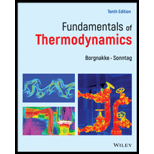
Fundamentals Of Thermodynamics
10th Edition
ISBN: 9781119494966
Author: Borgnakke, C. (claus), Sonntag, Richard Edwin, Author.
Publisher: Wiley,
expand_more
expand_more
format_list_bulleted
Question
error_outline
This textbook solution is under construction.
Students have asked these similar questions
Consider the two flows through identical nozzles sketched below. If the reservoir pressures and temperature are the same for the two flows, calculate the ratio of
the mass flow rates at the exits of the nozzles, m,/m, .
Me >d0
At
Ae/At=4
M-1
Me
(b) Air flows through a cylindrical duct at a rate of 2.3 kg/s. Friction between air and the
duct and friction within air can be neglected. The diameter of the duct is 10cm and the
air temperature and pressure at the inlet are T₁ 450 K and P₁ = 200 kPa. If the Mach
number at the exit is Ma2
determine the rate of heat transfer and the pressure
difference across the duct. The constant pressure specific heat of air is cp = 1.005
kJ/kg-K. The gas constant of air is R = 0.287 kJ/kg-K and assume k = 1.4.
-
3. In figure shown, pipes 1 and 2 are of diameter 3 cm, D3 = 4 cm.
Alcohol (SG = 0.80) enters section 1 at 6 m/s while water enters at
section 2 at 10 m/s. Assuming ideal mixing of incompressible fluids,
compute the exit velocity and density of the mixture at section 3. The
temperature is 20°C. Answer: 9 m/s, 928 kg/m3
(2)
Ideal mixing
(3)
V₂-P3
Knowledge Booster
Learn more about
Need a deep-dive on the concept behind this application? Look no further. Learn more about this topic, mechanical-engineering and related others by exploring similar questions and additional content below.Similar questions
- (4) A water hose connected to a nozzle is used to fill a 10 L container. The internal diameter of the hose is 2 cm and the nozzle exit has an inner diameter of 1.7 cm. It takes 30 s to fill up the container. If the inlet pressure is 2 atm and the nozzle exit is 0.8 m above the hosea. What is the velocity (m/s) of water at the outlet stream and at the inlet stream?b. What is the water pressure (atm) at the outlet stream c. What is the mass flow rate of water (kg/s)?arrow_forwardIt is a Thermodynamics subject please show the complete and step by step solution. Use the given format I inserted. Please answer it as soon as possible.arrow_forwardA large vessel contains compressed air at To = 350 K and Po = 2 bar. A converging-diverging nozzle is attached to the vessel to discharge air. The throat area of the nozzle is 200 cm2. At the exit, the pressure is 20 kPa and the flow is supersonic. Answer the followings:arrow_forward
- Air enters a nozzle that has an inlet area of 0.4 m?, at 200 kPa, 500 °C. and 30 m/s. At the exit the conditions are 100 kPa and 443 °C. Part A If the exit area is 45 cm? , determine the steady-state exit velocity. Use the IG flow-state TESTcalc. Express the steady-state exit velocity in meters per second to four significant figures. ΑΣφ vec ? V. = m/s Submit Request Answerarrow_forwardQ.2. Air flows through a constant-area duct is connected to a reservoir at a temperature of 500°C and a pressure of 500 kPa by a converging nozzle, as shown in Figure. Heat is lost at the rate of 250 kJ /kg. Determine the exit pressure and Mach number and the mass flow rate for a back pressure of 0 kPa. q = 250 kJ/kg Pr = 500 kPa Tr = 500°C Po = 0 kPa D= 0.02marrow_forwardDon't use chatgpt will upvotearrow_forward
- Air flows through a converging-diverging (c-d) nozzle. It is supplied from a large air reservoir in which the temperature is 446 K and the pressure is 190 kPa. The velocity and the cross-sectional area at the nozzle exit are 594 m/s and 0.0005 m^2, respectively. Find the followings: Mach number at exit is Area of the throat is The mass flow rate of air is The exit temperature is The exit pressure isarrow_forwardA=1arrow_forwardAir at 30 lbf/in2 absolute and 200F flows from a reservoir into a duct. The flow is steady, adiabatic, frictionless. The flow rate is 10lbm/s. What are the cross-sectional area, temperature, pressure, and Mach number at the point in the duct where the velocity is 1,400 ft/s?arrow_forward
arrow_back_ios
SEE MORE QUESTIONS
arrow_forward_ios
Recommended textbooks for you
 Elements Of ElectromagneticsMechanical EngineeringISBN:9780190698614Author:Sadiku, Matthew N. O.Publisher:Oxford University Press
Elements Of ElectromagneticsMechanical EngineeringISBN:9780190698614Author:Sadiku, Matthew N. O.Publisher:Oxford University Press Mechanics of Materials (10th Edition)Mechanical EngineeringISBN:9780134319650Author:Russell C. HibbelerPublisher:PEARSON
Mechanics of Materials (10th Edition)Mechanical EngineeringISBN:9780134319650Author:Russell C. HibbelerPublisher:PEARSON Thermodynamics: An Engineering ApproachMechanical EngineeringISBN:9781259822674Author:Yunus A. Cengel Dr., Michael A. BolesPublisher:McGraw-Hill Education
Thermodynamics: An Engineering ApproachMechanical EngineeringISBN:9781259822674Author:Yunus A. Cengel Dr., Michael A. BolesPublisher:McGraw-Hill Education Control Systems EngineeringMechanical EngineeringISBN:9781118170519Author:Norman S. NisePublisher:WILEY
Control Systems EngineeringMechanical EngineeringISBN:9781118170519Author:Norman S. NisePublisher:WILEY Mechanics of Materials (MindTap Course List)Mechanical EngineeringISBN:9781337093347Author:Barry J. Goodno, James M. GerePublisher:Cengage Learning
Mechanics of Materials (MindTap Course List)Mechanical EngineeringISBN:9781337093347Author:Barry J. Goodno, James M. GerePublisher:Cengage Learning Engineering Mechanics: StaticsMechanical EngineeringISBN:9781118807330Author:James L. Meriam, L. G. Kraige, J. N. BoltonPublisher:WILEY
Engineering Mechanics: StaticsMechanical EngineeringISBN:9781118807330Author:James L. Meriam, L. G. Kraige, J. N. BoltonPublisher:WILEY

Elements Of Electromagnetics
Mechanical Engineering
ISBN:9780190698614
Author:Sadiku, Matthew N. O.
Publisher:Oxford University Press

Mechanics of Materials (10th Edition)
Mechanical Engineering
ISBN:9780134319650
Author:Russell C. Hibbeler
Publisher:PEARSON

Thermodynamics: An Engineering Approach
Mechanical Engineering
ISBN:9781259822674
Author:Yunus A. Cengel Dr., Michael A. Boles
Publisher:McGraw-Hill Education

Control Systems Engineering
Mechanical Engineering
ISBN:9781118170519
Author:Norman S. Nise
Publisher:WILEY

Mechanics of Materials (MindTap Course List)
Mechanical Engineering
ISBN:9781337093347
Author:Barry J. Goodno, James M. Gere
Publisher:Cengage Learning

Engineering Mechanics: Statics
Mechanical Engineering
ISBN:9781118807330
Author:James L. Meriam, L. G. Kraige, J. N. Bolton
Publisher:WILEY
Intro to Compressible Flows — Lesson 1; Author: Ansys Learning;https://www.youtube.com/watch?v=OgR6j8TzA5Y;License: Standard Youtube License